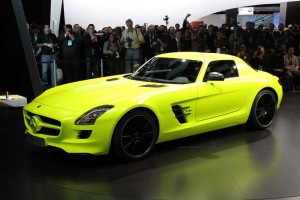Mercedes-Benz plans to introduce a plug-in hybrid version of S-Class by mid-decade and launch an electric version of the SLS AMG “gull wing,” Daimler CEO Dieter Zetsch told shareholders at the company’s annual general meeting in Berlin.
“We now manufacture four fully electric models, which is more than any other automaker worldwide,” said Zetsche, citing production of the Smart electric drive, the A-Class E-Cell, the small Vito Van E-Cell and the B-Class F-Cell.
“Three of these models – the Smart, the A-Class and the Vito –rely solely on a battery-electric drive system” said Zetsche. “Our experience has been so positive that we will soon be introducing additional models,” he said.
Among the models under development is a plug-in hybrid version of the next-generation S-Class, Zetsche revealed, “in other words a ‘partially electric’ vehicle whose battery can be recharged from a normal power source,” he said.
In 2013, Mercedes will launch the SLS AMG E-cell, a battery-powered version of the maker’s gull-winged supercar, Zetsche said. “This newcomer will leave no doubt that ‘clean’ and ‘fascinating’ need not be mutually exclusive,” he said. (For more on the SLS E-Cell, Click Here.)
Beginning next year, the E-Class will be available as a diesel-hybrid model with CO2 emissions well below 120 grams per kilometer.
Despite complaints from some critical shareholders, that Daimler’s electrification program is simply “greenwashing,” aimed at hiding the company’s weak environmental record, Zetsche said the improvements in emissions and fuel economy are being made across the Mercedes model line.
Mercedes-Benz is also making progress with the fuel consumption of vehicles with conventional drive systems, he stressed.
Despite the traditionally high proportion of large automobiles in the Group’s model mix, the CO2 emissions of the car fleet sold in Europe were reduced in 2010 to an average of 158 grams per kilometer.
In 2011, the fleet’s CO2 value will be reduced significantly once again, the CEO promised. The combination of new, highly efficient engines and the new 7-speed automatic transmission with a start-stop system reduces fuel consumption by up to 31%, depending on the model.
A large number of other measures will help the Group not only to meet the limits set by the European Union for 2015, but to improve on them.
By 2016, Daimler intends to undertake a further reduction in CO2 emissions to achieve an average of 125 grams per kilometer for the entire car fleet. Vehicles with hybrid drive, a combination of internal-combustion engine and electric motor, will make an increasing contribution to meeting the target.
“The contribution made by hybrids towards achieving this goal will increase in the future,” he said. “Hybridization makes the most sense in the larger models, as customers can drive solely on electric power for stretches in cities and use the same car for longer trips without any problems,” Zetsche added.

